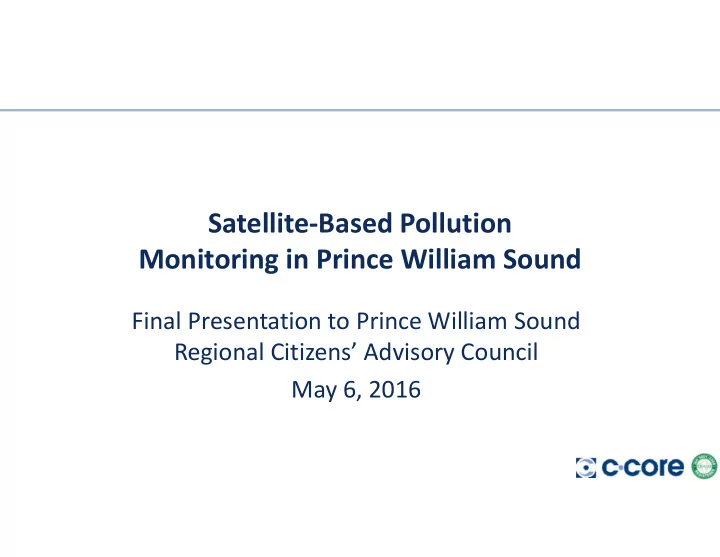

Satellite ‐ Based Pollution Monitoring in Prince William Sound Final Presentation to Prince William Sound Regional Citizens’ Advisory Council May 6, 2016
Outline Introduction Approach Results Conclusions and Recommendations
Introduction Project Objective – Demonstrate capabilities of satellite ‐ based pollution monitoring in Prince William Sound – April 2015 to January 2016 Project Tasks – Compile ancillary information – Adjust detection processes to local conditions – Establish monitoring plan – Execute monitoring program
Introduction Satellite ‐ based oil slick monitoring – Primarily based on satellite radar imagery – Radar imagery is largely weather independent – Detection of slicks as dark objects against a brighter background – Other phenomena cause signatures similar to oil slicks • wind shadow, fronts, biogenic slicks, algal blooms, ship wakes, freshwater, sea ice, etc.
Examples of Satellite ‐ Based Slick Detection Oil slick Canadian Space Agency, 2002
Operational Satellite Radar Missions
Introduction Operational Satellite ‐ based oil slick detection – Radar imagery is available in NRT – Approaches range from manual to semi ‐ automated extraction – Operator intervention is critical to differentiate between slicks and look ‐ alikes • Shape • Context • Brightness • Environmental conditions
Approach Area of interest – PWS – Major shipping lane (1km buffer) Satellite data – Sentinel ‐ 1 – Freely available – (Pre ‐ )operational
Satellite Imagery (Sentinel ‐ 1)
Ancillary Data Environmental parameters from Alaska Ocean Observing System (AOOS) – Surface wind speed – Presence of sea ice – Algae blooms – Shoreline residual oil
Analysis Dual focus – Detection of potential slicks (dark targets) – Detection of large vessels (bright targets) in shipping lane – Both applications share common processing elements – Operational procedures in place at C ‐ CORE
Results Surveillance Products
Results
Examples of Slick Look ‐ Alikes and Vessels
Results No potential oil slicks were detected during this investigation – Limited number of images processed – Complexity of the AOI – Low probability of occurrence of voluntary or accidental oil spills
Results Lessons learned from major surveillance programs Integrated Satellite Tracking of Pollution (ISTOP) (Canada) and CleanSeaNet (Europe) – ISTOP processed more than 10,000 images since 2006 with 258 possible oil slicks identified (Environment Canada, 2015) • Approximately 50 images processed on average to detect one potential slick – ISTOP and CleanSeaNet process comparable number of satellite images on a yearly basis • Number of detected potential slicks per image is much higher for CleanSeaNet, reflecting higher maritime traffic density
Results Lessons learned from major surveillance programs ISTOP (Canada) and CleanSeaNet (Europe) – CleanSeaNet also shows a global reduction in the number of potential slicks detected per image from 1.38 in 2008 to 0.75 in 2009 (EMSA, 2011) – Decline in detections under ISTOP and CleanSeaNet suggests satellite monitoring programs are effective deterrents – Regular, public promotion of the surveillance program important to ensure regulatory compliance
Conclusion Sentinel ‐ 1 imagery – AOI was infrequently covered – Imagery was often not available within 2 h – Data is freely available Going forward – Sentinel ‐ 1 B launched in April – More complete coverage of western Arctic expected – Possibility to lobby ESA for increased coverage – Include optical imagery from Sentinel ‐ 2
Conclusion Satellite ‐ based oil slick monitoring is fully operational and applicable anywhere in the world within the limitations inherent in the technology – To be effective, satellite ‐ based monitoring should be conducted in near real ‐ time (~2h between satellite observation and report generation) – Streamlined, operational process is required that integrates with existing processes and procedures
Conclusion Basic framework for satellite ‐ based slick detection can be expanded to include other elements of satellite surveillance – Iceberg and ship detection as demonstrated – Sea ice – Water quality (optical imagery) – Optical/radar synergies
Recommendations Take advantage of freely available Sentinel ‐ 1 imagery over PWS to implement an ongoing, regular satellite surveillance program Monitoring should be carried out at a meaningful frequency (once fully operational, Sentinel ‐ 1 imagery should be available over PWS at least twice per week)
Recommendations Implement a capacity for image analysis in near real ‐ time, together with suitable response actions to potential slicks detected (e.g. identify pollution control authorities) In addition to potential oil slicks, the satellite monitoring program should consider the detection of vessels and icebergs in the PWS area
Recommendations Over time, satellite ‐ based products should be re ‐ analyzed to reveal spatial and temporal distributions of potential oil slicks, vessels and icebergs The design of a satellite monitoring program should be flexible to accommodate future additions (e.g. Sentinel ‐ 2 imagery)
Recommend
More recommend